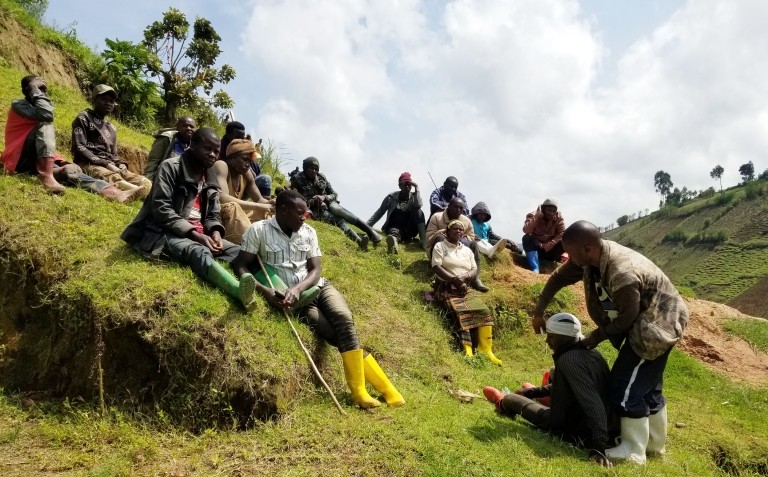Blog
In DRC, first aid trainings, outreach help miners improve occupational health and safety

Pact works in partnership with governments, industry and artisanal miners to make small-scale mining (ASM) safer, more productive and equitable.
In the Democratic Republic of Congo, we’ve been improving occupational health and safety (OHS) at mine sites by training local mining stakeholders, including artisanal miners, mining cooperatives and state mining services. In addition, Pact has worked on DRC’s Mining Code and Regulations on ASM that were adopted in 2018.
Building on the first year of our formalization and governance project funded by AOC International (Europe) B.V. and MMD-Monitors & Displays Nederland B.V. (Philips Monitors), and implemented alongside the DRC NGO Bepat, in 2022 we extended training and outreach activities to reach more miners and mine sites, install sign boards with OHS messaging, conduct first aid classes and overall improve mine site safety.
Originating in DRC's Goma and North Kivu in 2021, the project expanded to Rubaya in the Masisi territory in 2022. Pact continued to disseminate a well-received booklet from the project’s first year covering key legal aspects of the Congolese Mining Code and Regulation.
During the project’s second year, Pact rolled out additional trainings to accompany the booklet for miners working at tin, tungsten and tantalum (3T) artisanal mine sites. These additional trainings were focused on OHS awareness, first aid skills and legal requirements in the DRC mining code.
The first aid trainings were particularly effective and sustainable because of their practical demonstrations. These trainings were led by a supervisor from SAEMAPE (Service d’Assistance et d’Encadrement de l’Exploitation Minière Artisanale et à Petite Echelle), the DRC government agency mandated to support the ASM sector.
Through five training sessions, we reached 456 participants (17% women) including miners, OHS committee members and nearby community members.
In these sessions, the group learned four techniques for stabilizing injured miners for evacuation or until medical staff arrive. These techniques included how to stop bleeding, immobilize fractured limbs, make a lateral security position and transport victims.

The creation of OHS committees
In addition to hands-on first aid training, another key success has been the creation of OHS committees comprised of 20-plus members who are trained with the project’s booklet.
These members serve as regional trainers, and their responsibility is to pass on mining knowledge by training other miners and cooperatives. The committees also serve as a forum to discuss challenges, successes and how lessons learned can be practically applied in other regions participating in the project.
The support of local leaders has been crucial to identifying mines to expand the training and thereby create new OHS committees.
These OHS committees include representatives of mining cooperatives, technical service agents from the Ministry of Mines (SAEMAPE and DIVIMINES) and the Mining Police (PMH). During project and OHS committee meetings, local leaders also highlighted additional areas with recent increases in accidents and health and safety issues that could benefit from trainings and OHS committees.
The interventions are making an important difference. Mr. Emmanuel, the secretary and mining operations manager of the mining cooperative COMIDC, believes the trainings and OHS committee at their mine site will enable the monitoring and resolution of OHS-related issues and accidents, such as flooding and landslides.
“I think that the risk of accidents on the site can be significantly reduced if the cooperative takes its responsibilities and puts into practice what was learned during the training,” COMIDC site manager Fidèle Rukapa said. “I have visited more than three sites and noted that the miners are equipped with PPE, and their wells are dug correctly and protected by wooden support.”
Engaged communities
Beyond helping to build safer, more responsible practices, the OHS trainings and committees are building ownership and engagement among local stakeholders.
Through the OHS committees, miners and mine sites conduct their own assessments to identify and address risks and violations of the mining code. For example, some mines added sign boards to the entrances of their sites with pictures and messages to easily communicate safe mining practices.
As of the end of 2022, the project had directly benefitted 3,135 miners (including 274 women) across 11 mine sites, and 300 community members (including 50 women) across five mining sectors. In addition, the project installed 20 signboards and distributed 200 posters and booklets on the DRC Mining Code and OHS at key locations.
As we enter the third and final year of the project, AOC, MMD, Bepat and Pact are looking forward to expanding trainings to more mines and communities, further developing the capacity of local stakeholders and government agencies, establishing more OHS committees, and continuing to foster systemic change in safety, knowledge and practical application of the DRC Mining Code across the country’s Masisi mining territories.